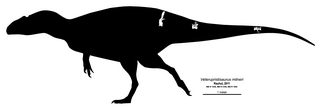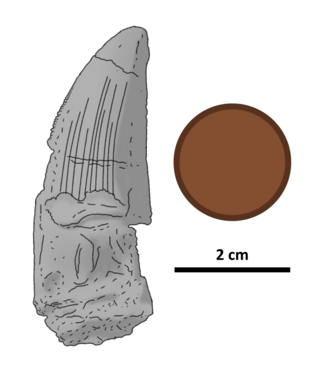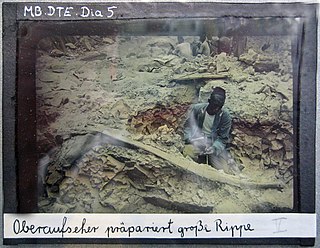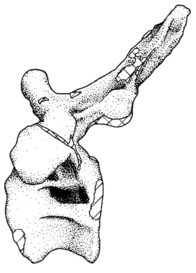Gigantosaurus is a dubious genus of sauropod dinosaur from the Late Jurassic Kimmeridge Clay Formation of England. The type species, Gigantosaurus megalonyx, was named and described by Harry Govier Seeley in 1869.

Kentrosaurus is a genus of stegosaurid dinosaur from the Late Jurassic in Lindi Region of Tanzania. The type species is K. aethiopicus, named and described by German palaeontologist Edwin Hennig in 1915. Often thought to be a "primitive" member of the Stegosauria, several recent cladistic analyses find it as more derived than many other stegosaurs, and a close relative of Stegosaurus from the North American Morrison Formation within the Stegosauridae.

Diplodocids, or members of the family Diplodocidae, are a group of sauropod dinosaurs. The family includes some of the longest creatures ever to walk the Earth, including Diplodocus and Supersaurus, some of which may have reached lengths of up to 42 metres (138 ft).

Barosaurus was a giant, long-tailed, long-necked, plant-eating sauropod dinosaur closely related to the more familiar Diplodocus. Remains have been found in the Morrison Formation from the Upper Jurassic Period of Utah and South Dakota. It is present in stratigraphic zones 2–5.

Cetiosauriscus is a genus of sauropod dinosaur that lived between 166 and 164 million years ago during the Callovian in what is now England. A herbivore, Cetiosauriscus had — by sauropod standards — a moderately long tail, and longer forelimbs, making them as long as its hindlimbs. It has been estimated as about 15 m (49 ft) long and between 4 and 10 t in weight.

Giraffatitan is a genus of sauropod dinosaur that lived during the late Jurassic Period in what is now Lindi Region, Tanzania. Only one species is known, G. brancai, named in honor of German paleontologist Wilhelm von Branca, who was a driving force behind the expedition that discovered it in the Tendaguru Formation. Giraffatitan brancai was originally described by German paleontologist Werner Janensch as a species of the North American sauropod Brachiosaurus from the Morrison Formation, as Brachiosaurus brancai. Recent research shows that the differences between the type species of Brachiosaurus and the Tendaguru material are so large that the African material should be placed in a separate genus.

Elaphrosaurus is a genus of ceratosaurian theropod dinosaur that lived approximately 154 to 150 million years ago during the Late Jurassic Period in what is now Tanzania in Africa. Elaphrosaurus was a medium-sized but lightly built member of the group that could grow up to 6.2 m (20 ft) long. Morphologically, this dinosaur is significant in two ways. Firstly, it has a relatively long body but is very shallow-chested for a theropod of its size. Secondly, it has very short hindlimbs in comparison with its body. Phylogenetic analyses indicate that this genus is likely a ceratosaur. Earlier suggestions that it is a late surviving coelophysoid have been examined but generally dismissed. Elaphrosaurus is currently believed to be a very close relative of Limusaurus, an unusual beaked ceratosaurian which may have been either herbivorous or omnivorous.

Janenschia is a large herbivorous sauropod dinosaur from the Late Jurassic Tendaguru Formation of Lindi Region, Tanzania around 155 million years ago.

Lindi District also known as Mtama District is one of six administrative districts of Lindi Region in Tanzania. The District covers an area of 5,975 km2 (2,307 sq mi). Kilwa district is bordered to the north by Kilwa District, to the east by the Indian Ocean and Lindi Municipal District, to the south by the Mtwara Region, and to the west by the Nachingwea District. The district seat (capital) is the town and ward of Mtama. The district is known for the Tendaguru Formation, the richest Late Jurassic strata of fossils in Africa. According to the 2012 census, the district has a total population of 191,143.

Tendaguria is a genus of herbivorous sauropod dinosaur from the Late Jurassic of Lindi Region, Tanzania.

The Tendaguru Formation, or Tendaguru Beds are a highly fossiliferous formation and Lagerstätte located in the Lindi Region of southeastern Tanzania. The formation represents the oldest sedimentary unit of the Mandawa Basin, overlying Neoproterozoic basement, separating by a long hiatus and unconformity. The formation reaches a total sedimentary thickness of more than 110 metres (360 ft). The formation ranges in age from the late Middle Jurassic to the Early Cretaceous, Oxfordian to Hauterivian stages, with the base of the formation possibly extending into the Callovian.

Australodocus is a genus of sauropod dinosaur that lived during the Late Jurassic period, around 150 million years ago, in what is now Lindi Region, Tanzania. Though initially considered a diplodocid, recent analyses suggest it may instead be a titanosauriform.

Diplodocus was a genus of diplodocid sauropod dinosaurs, whose fossils were first discovered in 1877 by S. W. Williston. The generic name, coined by Othniel Charles Marsh in 1878, is a Neo-Latin term derived from Greek διπλός (diplos) "double" and δοκός (dokos) "beam", in reference to the double-beamed chevron bones located in the underside of the tail, which were then considered unique.

Brachiosaurus is a genus of sauropod dinosaur that lived in North America during the Late Jurassic, about 154 to 150 million years ago. It was first described by American paleontologist Elmer S. Riggs in 1903 from fossils found in the Colorado River valley in western Colorado, United States. Riggs named the dinosaur Brachiosaurus altithorax; the generic name is Greek for "arm lizard", in reference to its proportionately long arms, and the specific name means "deep chest". Brachiosaurus is estimated to have been between 18 and 22 meters long; body mass estimates of the subadult holotype specimen range from 28.3 to 46.9 metric tons. It had a disproportionately long neck, small skull, and large overall size, all of which are typical for sauropods. Atypically, Brachiosaurus had longer forelimbs than hindlimbs, which resulted in a steeply inclined trunk, and a proportionally shorter tail.

Gustav Tornier was a German zoologist and herpetologist.

Veterupristisaurus is an extinct genus of carcharodontosaurid theropod dinosaur known from the Jurassic of Tendaguru, Lindi Region of southeastern Tanzania.

Ostafrikasaurus is a genus of theropod dinosaur from the Late Jurassic period of what is now Lindi Region, Tanzania. It is known only from fossil teeth discovered sometime between 1909 and 1912, during an expedition to the Tendaguru Formation by the Natural History Museum of Berlin. Eight teeth were originally attributed to the dubious dinosaur genus Labrosaurus, and later to Ceratosaurus, both known from the North American Morrison Formation. Subsequent studies attributed two of these teeth to a spinosaurid dinosaur, and in 2012, Ostafrikasaurus crassiserratus was named by French palaeontologist Eric Buffetaut, with one tooth as the holotype, and the other referred to the same species. The generic name comes from the German word for German East Africa, the former name of the colony in which the fossils were found, while the specific name comes from the Latin words for "thick" and "serrated", in reference to the form of the animal's teeth.

Kaatedocus is a genus of flagellicaudatan sauropod known from the middle Late Jurassic of northern Wyoming, United States. It is known from well-preserved skull and cervical vertebrae which were collected in the lower part of the Morrison Formation. The type and only species is Kaatedocus siberi, described in 2012 by Emanuel Tschopp and Octávio Mateus.
Wamweracaudia is a large herbivorous sauropod dinosaur from the Late Jurassic Tendaguru Formation of Tanzania, Africa, 155-145 million years ago.

Boheti bin Amrani was a Tanzanian farmer. In 1909 he served first as a guide, and then the chief supervisor and preparator for the 1909–1913 German Tendaguru Expedition. A sauropod dinosaur, Australodocus bohetii, was named after him in 2007.
































